Population Density or Populations Size. Which Factor Determines Urban Traffic Congestion?
Abstract
1. Introduction
2. Literature Review
2.1. Aggregate and Disaggregate Analysis of Traffic Congestion
2.2. Comparison of Transit Capacity and Usage: The U.S. versus Europe
3. Method and Data
4. Analysis of Results
5. Conclusions
Author Contributions
Funding
Institutional Review Board Statement
Informed Consent Statement
Data Availability Statement
Acknowledgments
Conflicts of Interest
Appendix A
| Rank of Population | City | Traffic Index (%) | Population (2010) | Income per Capita (in $) | Density (Population per m2) |
|---|---|---|---|---|---|
| 1 | Mexico City | 66 | 19,255,921 | 20,215.63 | 18,900 |
| 2 | Los Angeles | 45 | 17,053,745 | 51,053.36 | 6400 |
| 3 | New York | 35 | 16,539,429 | 71,109.83 | 4600 |
| 4 | London | 40 | 11,793,530 | 52,237.95 | 13,200 |
| 5 | Paris | 38 | 11,693,219 | 60,450.15 | 8700 |
| 6 | Chicago | 26 | 9,461,104 | 56,441.72 | 3900 |
| 7 | San Francisco | 39 | 6,848,028 | 76,564.96 | 5600 |
| 8 | Madrid | 25 | 6,507,502 | 43,229.84 | 14,100 |
| 9 | Toronto | 30 | 6,418,623 | 40,672.78 | 6400 |
| 10 | Santiago | 43 | 6,393,830 | 21,815.31 | 15,800 |
| 11 | Houston | 24 | 5,920,500 | 67,964.36 | 3300 |
| 12 | Washington | 29 | 5,636,185 | 77,356.4 | 3400 |
| 13 | Miami | 30 | 5,564,641 | 45,055.92 | 4400 |
| 14 | Sydney | 39 | 4,555,516 | 41,163.05 | 5300 |
| 15 | Atlanta | 27 | 4,377,197 | 58,611.71 | 1800 |
| 16 | Berlin | 29 | 4,374,708 | 36,532.48 | 9700 |
| 17 | Montreal | 29 | 4,169,714 | 34,588.1 | 5100 |
| 18 | Dallas | 18 | 4,145,124 | 66,430.82 | 2900 |
| 19 | Melbourne | 33 | 4,105,858 | 37,940.97 | 4100 |
| 20 | Milan | 30 | 4,060,624 | 58,845.9 | 4700 |
| 21 | Philadelphia | 23 | 4,024,830 | 58,040.46 | 2900 |
| 22 | Rome | 40 | 4,008,095 | 48,383.29 | 8300 |
| 23 | Detroit | 16 | 3,863,924 | 48,862.76 | 3100 |
| 24 | Phoenix | 16 | 3,817,117 | 46,708.03 | 3600 |
| 25 | Barcelona | 31 | 3,675,206 | 38,232.79 | 13,100 |
| 26 | Boston | 28 | 3,639,144 | 80,446.39 | 2200 |
| 27 | Athens | 37 | 3,563,607 | 41,327.19 | 14,100 |
| 28 | Naples | 33 | 3,552,568 | 22,693.61 | 10,000 |
| 29 | Minneapolis | 16 | 3,348,859 | 59,931.46 | 2700 |
| 30 | San Diego | 27 | 3,095,313 | 56,602.03 | 3400 |
| 31 | Hamburg | 33 | 2,984,966 | 52,203.59 | 7100 |
| 32 | Warsaw | 37 | 2,981,198 | 43,220.62 | 9600 |
| 33 | Budapest | 22 | 2,846,464 | 36,383.2 | 6000 |
| 34 | Munich | 30 | 2,844,749 | 60,969.98 | 9600 |
| 35 | Lisbon | 36 | 2,797,612 | 38,308.21 | 6300 |
| 36 | Vienna | 31 | 2,683,251 | 47,076.79 | 9200 |
| 37 | Seattle | 34 | 2,644,466 | 81,820.3 | 2800 |
| 38 | Katowice | 17 | 2,628,207 | 23,544.08 | 8800 |
| 39 | Saint Louis (US) | 13 | 2,559,926 | 50,708.89 | 2500 |
| 40 | Denver | 20 | 2,551,341 | 60,606.95 | 4000 |
| 41 | Frankfurt | 28 | 2,517,805 | 56,430.53 | 8800 |
| 42 | Brussels | 38 | 2,485,480 | 54,631.33 | 5600 |
| 43 | Amsterdam | 22 | 2,360,958 | 51,664.7 | 6900 |
| 44 | Vancouver | 39 | 2,312,497 | 38,896.62 | 4500 |
| 45 | Sacramento/Roseville | 22 | 2,149,127 | 44,583.68 | 3800 |
| 46 | San Antonio | 20 | 2,142,508 | 38,053.07 | 3300 |
| 47 | Orlando | 20 | 2,134,411 | 47,411.67 | 2600 |
| 48 | Brisbane | 28 | 2,108,348 | 40,495.97 | 2400 |
| 49 | Cincinnati | 14 | 2,107,074 | 49,612.88 | 2200 |
| 50 | Kansas City | 11 | 2,009,344 | 53,458.74 | 2300 |
| 51 | Las Vegas | 24 | 1,995,215 | 43,392.82 | 4600 |
| 52 | Copenhagen | 23 | 1,989,871 | 49,396.2 | 6100 |
| 53 | Stockholm | 28 | 1,964,829 | 59,970.73 | 8600 |
| 54 | Baltimore | 19 | 1,957,901 | 57,239.36 | 3000 |
| 55 | Stuttgart | 34 | 1,954,756 | 52,425.89 | 7900 |
| 56 | Cologne | 34 | 1,903,154 | 46,880.74 | 5600 |
| 57 | Lyon | 29 | 1,894,945 | 44,700.19 | 3800 |
| 58 | Birmingham (UK) | 26 | 1,884,199 | 31,555.11 | 9900 |
| 59 | Manchester | 38 | 1,841,382 | 37,290.18 | 10,400 |
| 60 | Prague | 28 | 1,829,843 | 47,763.9 | 10,900 |
| 61 | Perth | 27 | 1,781,132 | 64,368.88 | 3100 |
| 62 | Turin | 25 | 1,747,614 | 39,019 | 7000 |
| 63 | Marseille | 40 | 1,722,236 | 37,015.14 | 3100 |
| 64 | Austin | 25 | 1,716,283 | 51,069.08 | 2800 |
| 65 | Indianapolis | 11 | 1,658,600 | 63,942.48 | 2200 |
| 66 | Dublin | 43 | 1,650,202 | 57,273.71 | 7400 |
| 67 | Valencia | 23 | 1,570,517 | 30,441.55 | 11,200 |
| 68 | Milwaukee | 13 | 1,555,908 | 56,077.22 | 2700 |
| 69 | Cleveland | 12 | 1,510,163 | 62,025.09 | 2800 |
| 70 | Rotterdam | 19 | 1,484,830 | 45,676.02 | 6400 |
| 71 | Helsinki | 16 | 1,455,677 | 53,154.43 | 6100 |
| 72 | Seville | 25 | 1,421,045 | 26,445.16 | 14,400 |
| 73 | Ottawa-Gatineau | 28 | 1,386,544 | 39,189.63 | 4300 |
| 74 | Kraków | 38 | 1,351,831 | 24,237.5 | 8200 |
| 75 | Lille | 22 | 1,349,194 | 31,022.56 | 5700 |
| 76 | Jacksonville | 18 | 1,345,596 | 42,674.77 | 2100 |
| 77 | Memphis | 17 | 1,324,829 | 47,111.74 | 2400 |
| 78 | Porto | 27 | 1,300,285 | 25,300.07 | 7200 |
| 79 | Charlotte | 17 | 1,298,931 | 69,592.61 | 1700 |
| 80 | Calgary | 20 | 1,271,737 | 61,957.94 | 3600 |
| 81 | Adelaide | 27 | 1,253,097 | 36,662.65 | 3600 |
| 82 | Oklahoma City | 14 | 1,252,987 | 48,159.32 | 2300 |
| 83 | Mannheim | 24 | 1,240,964 | 42,997.92 | 8900 |
| 84 | Nashville | 23 | 1,239,565 | 57,311.23 | 1700 |
| 85 | Louisville | 17 | 1,235,708 | 47,104.17 | 2200 |
| 86 | Oslo | 30 | 1,225,202 | 60,611.41 | 8300 |
| 87 | Pittsburgh | 19 | 1,223,423 | 65,591.38 | 2100 |
| 88 | Hanover | 29 | 1,222,773 | 43,258.58 | 6600 |
| 89 | Toulouse | 28 | 1,217,316 | 39,352.55 | 2700 |
| 90 | Zurich | 31 | 1,206,312 | 61,496.19 | 7600 |
| 91 | New Orleans | 23 | 1,189,866 | 65,883.89 | 5100 |
| 92 | Edmonton | 20 | 1,169,701 | 61,957.94 | 2600 |
| 93 | Nuremberg | 30 | 1,166,976 | 45,539.94 | 7800 |
| 94 | Leeds | 26 | 1,166,267 | 36,564.48 | 10,500 |
| 95 | Buffalo | 16 | 1,135,509 | 41,937.14 | 2700 |
| 96 | Raleigh | 18 | 1,130,641 | 52,516.23 | 1700 |
| 97 | Salt Lake City | 16 | 1,125,301 | 59,997.28 | 3800 |
| 98 | Bordeaux | 31 | 1,121,983 | 35,859.6 | 2000 |
| 99 | Gdansk | 29 | 1,091,850 | 24,647.37 | 12,900 |
| 100 | Fresno | 19 | 1,081,742 | 32,741.63 | 4000 |
| 101 | Antwerp | 30 | 1,053,725 | 45,242.08 | 3600 |
| 102 | Newcastle | 32 | 1,050,561 | 26,967.74 | 10,800 |
| 103 | Bremen | 23 | 1,025,580 | 42,069.64 | 6200 |
| 104 | Bilbao | 16 | 997,311 | 39,892.96 | 15,000 |
| 105 | Tucson | 20 | 980,263 | 33,647.09 | 2500 |
| 106 | Thessalonica | 25 | 957,946 | 23,153.73 | 10,700 |
| 107 | Lódz | 51 | 956,156 | 23,413.22 | 13,300 |
| 108 | Tulsa | 12 | 948,014 | 50,150.1 | 2100 |
| 109 | Glasgow | 29 | 947,808 | 38,793.74 | 8400 |
| 110 | Palermo | 43 | 935,921 | 23,983.38 | 13,400 |
| 111 | Poznan | 34 | 934,001 | 33,721.75 | 7100 |
| 112 | Liverpool | 30 | 929,014 | 32,751.69 | 11,400 |
| 113 | Albuquerque | 16 | 887,077 | 43,740.28 | 2700 |
| 114 | Sheffield | 35 | 880,236 | 27,884.3 | 10,200 |
| 115 | Gothenburg | 23 | 877,149 | 41,114.96 | 6700 |
| 116 | Albany | 14 | 870,710 | 49,349.38 | 2000 |
| 117 | Nantes | 25 | 870,045 | 35,281.28 | 3100 |
| 118 | Omaha | 11 | 865,350 | 55,089.85 | 2800 |
| 119 | Nice | 29 | 845,186 | 36,935.75 | 3400 |
| 120 | Providence | 19 | 842,700 | 46,882.64 | 2300 |
| 121 | Leipzig | 24 | 837,610 | 31,192.13 | 5200 |
| 122 | Dresden | 26 | 836,995 | 31,540.9 | 5800 |
| 123 | Nottingham | 27 | 835,625 | 31,018.8 | 10,800 |
| 124 | Málaga | 22 | 834,023 | 24,858.77 | 9200 |
| 125 | Wroclaw | 35 | 832,974 | 28,682.28 | 12,500 |
| 126 | Zaragoza | 20 | 825,837 | 36,155.34 | 14,700 |
| 127 | Quebec | 24 | 820,529 | 34,588.1 | 2500 |
| 128 | El Paso | 17 | 804,122 | 30,984.07 | 3100 |
| 129 | Winnipeg | 24 | 803,601 | 36,342.14 | 3700 |
| 130 | Bristol | 34 | 795,480 | 43,403.14 | 10,200 |
| 131 | Geneva | 36 | 785,022 | 54,529.92 | 7400 |
| 132 | McAllen | 21 | 774,768 | 18,937.26 | 1700 |
| 133 | Strasbourg | 28 | 758,724 | 35,761.87 | 5000 |
| 134 | Bologna | 24 | 745,254 | 48,110.43 | 10,400 |
| 135 | Edinburgh | 40 | 727,619 | 44,885.33 | 9100 |
| 136 | Florence | 26 | 723,164 | 44,815.39 | 7100 |
| 137 | Utrecht | 18 | 716,648 | 52,927.46 | 9500 |
| 138 | Bratislava | 25 | 715,455 | 54,881.97 | 8700 |
| 139 | Rouen | 21 | 698,385 | 32,486.72 | 3800 |
| 140 | Dayton | 9 | 696,726 | 44,823.93 | 2200 |
| 141 | Karlsruhe | 25 | 686,938 | 48,127.25 | 7600 |
| 142 | Rennes | 27 | 671,929 | 34,897.79 | 3800 |
| 143 | Little Rock | 14 | 671,459 | 55,966.19 | 1800 |
| 144 | Leicester | 32 | 660,817 | 30,950.14 | 11,200 |
| 145 | Las Palmas | 27 | 658,957 | 27,249.89 | 17,500 |
| 146 | Malmö | 18 | 656,834 | 37,027.86 | 9300 |
| 147 | Grenoble | 28 | 649,285 | 34,839.83 | 3300 |
| 148 | Columbia | 13 | 646,877 | 44,153.68 | 1600 |
| 149 | Baton Rouge | 26 | 645,639 | 55,743.22 | 1700 |
| 150 | Colorado Springs | 18 | 645,626 | 40,548.24 | 2400 |
| 151 | Cardiff | 27 | 640,632 | 30,532.13 | 11,200 |
| 152 | Montpellier | 31 | 635,897 | 32,078.6 | 4800 |
| 153 | Graz | 29 | 608,420 | 41,510.68 | 3700 |
| 154 | Grand Rapids | 12 | 602,622 | 49,789.09 | 2100 |
| 155 | Portsmouth | 25 | 577,191 | 39,255.57 | 12,100 |
| 156 | Ghent | 18 | 576,408 | 35,359.67 | 4700 |
| 157 | Ljubljana | 16 | 567,097 | 38,662.37 | 10,700 |
| 158 | Toulon | 28 | 547,702 | 27,216.78 | 2000 |
| 159 | Akron | 10 | 541,781 | 44,418.32 | 1900 |
| 160 | Tallinn | 32 | 530,760 | 31,661.92 | 5700 |
| 161 | Freiburg im Breisgau | 23 | 527,581 | 39,673.2 | 12,400 |
| 162 | Saint-Étienne | 20 | 520,667 | 28,743.96 | 3300 |
| 163 | Gold Coast-Tweed Heads | 27 | 519,630 | 40,495.97 | 2500 |
| 164 | Richmond | 11 | 511,149 | 71,732.51 | 1900 |
| Average | 164 Cities (Total) | 25.8 | 2,236,921 | 44,631.82 | 6145 |
| 66 Cities (U.S.-Canada) | 20.5 | 2,598,129 | 52,048.61 | 3139 | |
| 98 Cities (Remaining countries) | 29.3 | 1,993,658 | 39,636.83 | 8169 |
References
- Zhang, K.; Batterman, S. Air pollution and health risks due to vehicle traffic. Sci. Total Environ. 2013, 450, 307–316. [Google Scholar] [CrossRef] [PubMed]
- Levy, J.I.; Buonocore, J.J.; Von Stackelberg, K. Evaluation of the public health impacts of traffic congestion: A health risk assessment. Environ. Health A Glob. Access Sci. Source 2010, 9, 65. [Google Scholar] [CrossRef]
- Sweet, M. Does traffic congestion slow the economy? J. Plan. Lit. 2011, 26, 391–404. [Google Scholar] [CrossRef]
- Weisbrod, G.; Vary, D.; Treyz, G. Measuring economic costs of urban traffic congestion to business. Transp. Res. Rec. 2003, 1839, 98–106. [Google Scholar] [CrossRef]
- Ewing, R.; Cervero, R. Travel and the built environment: A meta-analysis. J. Am. Plan. Assoc. 2010, 76, 265–294. [Google Scholar] [CrossRef]
- Stevens, M.R. Does compact development make people drive less? J. Am. Plan. Assoc. 2017, 83, 7–18. [Google Scholar] [CrossRef]
- Newman, P.; Kenworthy, J. Cities and Automobile Dependence: An International Sourcebook; Gower Technical: Aldershot, UK, 1989. [Google Scholar]
- Kenworthy, J.R.; Laube, F.B. Patterns of automobile dependence in cities: An international overview of key physical and economic dimensions with some implica tions for urban policy. Transp. Res. Part A Policy Pract. 1999, 33, 691–723. [Google Scholar] [CrossRef]
- TomTom Traffic Index. 2016. Available online: https://www.tomtom.com/en_gb/trafficindex. (accessed on 20 December 2020).
- Cohn, N. Real-time traffic information and navigation: An operational system. Trans. Res. Rec. 2009, 2129, 129–135. [Google Scholar] [CrossRef]
- Boarnet, M.G. A broader context for land use and travel behavior, and a research agenda. J. Am. Plan. Assoc. 2011, 77, 197–213. [Google Scholar] [CrossRef]
- Karathodorou, N.; Graham, D.J.; Noland, R.B. Estimating the effect of urban density on fuel demand. Energy Econ. 2010, 32, 86–92. [Google Scholar] [CrossRef]
- Sue, Q. The effect of population density, road network density, and congestion on household gasoline consumption in U.S. urban areas. Energy Econ. 2011, 33, 445–452. [Google Scholar] [CrossRef]
- Ye, H.; He, X.; Song, Y.; Li, X.; Zhang, G.; Lin, T.; Xiao, L. A sustainable urban form: The challenges of compactness from the viewpoint of energy consumption and carbon emission. Energy Build. 2015, 93, 90–98. [Google Scholar] [CrossRef]
- Gudipudi, R.; Fluschnik, T.; Ros, A.G.C.; Walther, C.; Kropp, J.P. City density and CO2 efficiency. Energy Policy 2016, 91, 352–361. [Google Scholar] [CrossRef]
- Bettencourt, L.M.A.; Lobo, J.; Helbing, D.; Kühnert, C.; West, G.B. Growth, innovation, scaling, and the pace of life in cities. Proc. Natl. Acad. Sci. USA 2007, 104, 7301–7306. [Google Scholar] [CrossRef] [PubMed]
- Bettencourt, L.M.A.; Lobo, J.; Strumsky, D.; West, G.B. Urban scaling and its deviations: Revealing the structure of wealth, innovation and crime across cities. PLoS ONE 2010, 5, e13541. [Google Scholar] [CrossRef]
- Fragkias, M.; Lobo, J.; Strumsky, D.; Seto, K.C. Does size matter? Scaling of CO2 emissions and U.S. Urban areas. PLoS ONE 2013, 8, e64727. [Google Scholar] [CrossRef]
- Oliveira, E.A.; Andrade, J.S.; Makse, H.A. Large cities are less green. Sci. Rep. 2014, 4, 4235. [Google Scholar] [CrossRef] [PubMed]
- Muller, N.Z.; Jha, A. Does environmental policy affect scaling laws between population and pollution? Evidence from American metropolitan areas. PLoS ONE 2017, 12, e0181407. [Google Scholar]
- Louf, R.; Barthelemy, M. How congestion shapes cities: From mobility patterns to scaling. Sci. Rep. 2014, 4, 5561. [Google Scholar] [CrossRef] [PubMed]
- Barthelemy, M. A global take on congestion in urban areas. Environ. Plan. B Plan. Des. 2016, 43, 800–804. [Google Scholar] [CrossRef]
- Bento, A.M.; Cropper, M.L.; Mobarak, A.M.; Vinha, K. The effects of urban spatial structure on travel demand in the United States. Rev. Econ. Stat. 2005, 87, 466–478. [Google Scholar] [CrossRef]
- Bhat, C.R.; Guo, J.Y. A comprehensive analysis of built environment characteristics on household residential choice and auto ownership levels. Transp. Res. Part B Methodol. 2007, 41, 506–526. [Google Scholar] [CrossRef]
- Brownstone, D.; Golob, T.F. The impact of residential density on vehicle usage and energy consumption. J. Urban Econ. 2009, 65, 91–98. [Google Scholar] [CrossRef]
- Duranton, G.; Turner, M.A. Urban form and driving: Evidence from US cities. J. Urban Econ. 2018, 108, 170–191. [Google Scholar] [CrossRef]
- Chang, Y.S.; Lee, Y.J.; Choi, S.S. Is there more traffic congestion in larger cities? Scaling analysis of the 101 largest U.S. urban centers. Trans. Policy 2017, 59, 54–63. [Google Scholar] [CrossRef]
- Lu, J.; Li, B.; Li, H.; Al-Barakani, A. Expansion of city scale, traffic modes, traffic congestion, and air pollution. Cities 2021, 108, 102974. [Google Scholar] [CrossRef]
- Ribeiro, H.V.; Rybski, D.; Kropp, J.P. Effects of changing population or density on urban carbon dioxide emissions. Nat. Commun. 2019, 10, 3204. [Google Scholar] [CrossRef]
- Bertaud, A.; Richardson, H.W. Transit and density: Atlanta, the United States and western Europe. In Urban Sprawl in Western Europe and the United States; Richardson, A., Bae, C., Eds.; Ashgate: London, UK, 2004; pp. 293–310. [Google Scholar]
- Freemark, Y. Is Transit Ridership Loss Inevitable? A U.S.-France Comparison. Available online: https://www.thetransportpolitic.com/2019/09/09/is-transit-ridership-loss-inevitable-a-u-s-france-comparison/ (accessed on 6 April 2021).
- Transport Research Board. Making Transit Work: Insight from Western Europe, Canada, and the United States. Available online: https://www.nap.edu/catalog/10110/making-transit-work-insight-from-western-europe-canada-and-the (accessed on 6 April 2021).
- Dietz, T.; Rosa, E.A. Rethinking the environmental impacts of population, affluence and technology. Hum. Ecol. Rev. 1994, 1, 277–300. [Google Scholar]
- Holdren, J.P.; Ehrlich, P.R. Human population and the global environment: Population growth, rising per capita material consumption, and disruptive technologies have made civilization a global ecological force. Am. Sci. 1974, 62, 282–292. [Google Scholar] [PubMed]
- York, R.; Rosa, E.A.; Dietz, T. STIRPAT, IPAT and ImPACT: Analytic tools for unpacking the driving forces of environmental impacts. Ecol. Econ. 2003, 46, 351–365. [Google Scholar] [CrossRef]
- Shi, A. The impact of population pressure on global carbon dioxide emissions, 1975–1996: Evidence from pooled cross-country data. Ecol. Econ. 2003, 44, 29–42. [Google Scholar] [CrossRef]
- Cole, M.A.; Neumayer, E. Examining the impact of demographic factors on air pollution. Popul. Environ. 2004, 26, 5–21. [Google Scholar] [CrossRef]
- Martínez-Zarzoso, I.; Bengochea-Morancho, A.; Morales-Lage, R. The impact of population on CO2 emissions: Evidence from European countries. Environ. Resour. Econ. 2007, 38, 497–512. [Google Scholar] [CrossRef]
- Poumanyvong, P.; Kaneko, S. Does urbanization lead to less energy use and lower CO2 emissions? A cross-country analysis. Ecol. Econ. 2010, 70, 434–444. [Google Scholar] [CrossRef]
- Martínez-Zarzoso, I.; Maruotti, A. The impact of urbanization on CO2 emissions: Evidence from developing countries. Ecol. Econ. 2011, 70, 1344–1353. [Google Scholar] [CrossRef]
- Dietz, T.; Rosa, E.A.; York, R. Environmentally efficient weil-being: Rethinking sustainability as the relationship between human well-being and environmental impacts. Hum. Ecol. Rev. 2009, 16, 114–123. [Google Scholar]
- Steinberger, J.K.; Krausmann, F.; Eisenmenger, N. Global patterns of materials use: A socioeconomic and geophysical analysis. Ecol. Econ. 2010, 69, 1148–1158. [Google Scholar] [CrossRef]
- Fischer-Kowalski, M.; Krausmann, F.; Giljum, S.; Lutter, S.; Mayer, A.; Bringezu, S.; Weisz, H. Methodology and indicators of economy wide material flow accounting. J. Ind. Ecol. 2011, 15, 855–876. [Google Scholar] [CrossRef]
- Chertow, M.R. The IPAT Equation and Its Variants. J. Ind. Ecol. 2000, 25, 313–337. [Google Scholar] [CrossRef]
- Uddin, G.A.; Alam, K.; Gow, G. Estimating the Major Contributors to Environmental Impacts in Australia. Environ. Ecol. Stat. 2016, 37, 1–14. [Google Scholar]
- Wang, M.; Che, Y.; Yang, K.; Wang, M.; Xiong, L.; Huang, Y. A local-scale low-carbon plan based on the STIRPAT model and the scenario method: The case of Minhang District, Shanghai, China. Energy Policy 2011, 19, 6981–6990. [Google Scholar] [CrossRef]
- Hansen, B.E. Threshold effects in non-dynamic panels: Estimation, testing, and inference. J. Econ. 1999, 93, 345–368. [Google Scholar] [CrossRef]
- Qi, S.; Li, Y. Threshold effects of renewable energy consumption on economic growth under energy transformation. Chinese J. Popul. Resour. Environ. 2017, 15, 312–321. [Google Scholar] [CrossRef]
- Yi, S.; Xiao, L.A. Application of threshold regression analysis to study the impact of regional technological innovation level on sustainable development. Renew. Sust. Energ. Rev. 2018, 89, 27–32. [Google Scholar] [CrossRef]
- Wu, H.T.; Hao, Y.; Weng, J.H. How does energy consumption affect China’s urbanization? New evidence from dynamic threshold panel models. Energy Policy 2019, 127, 24–38. [Google Scholar] [CrossRef]
- Qi, J. Study on the threshold effect of China’s industrial structure on carbon emission. IOP Conf. Ser. Earth Environ. Sci. 2020, 546, 022053. [Google Scholar] [CrossRef]
- Han, D.; Li, T.; Feng, S.; Shi, Z. Application of Threshold Regression Analysis to Study the Impact of Clean Energy Development on China’s Carbon Productivity. Int. J. Environ. Res. Public Health 2020, 17, 1060. [Google Scholar] [CrossRef]
- Raza, S.A.; Shah, N.; Qureshi, M.A.; Qaiser, S.; Ali, R.; Ahmed, F. Non-linear threshold effect of financial development on renewable energy consumption: Evidence from panel smooth trnsition regression approach. Environ. Sci. Pollut. Res. 2020, 27, 32034–32047. [Google Scholar] [CrossRef]
- Chang, T.H.; Huang, C.M.; Lee, M.C. Threshold effect of the economic growth rate on the renewable energy development from a change in energy price: Evidence from OECD countries. Energy Policy 2009, 37, 5796–5802. [Google Scholar] [CrossRef]
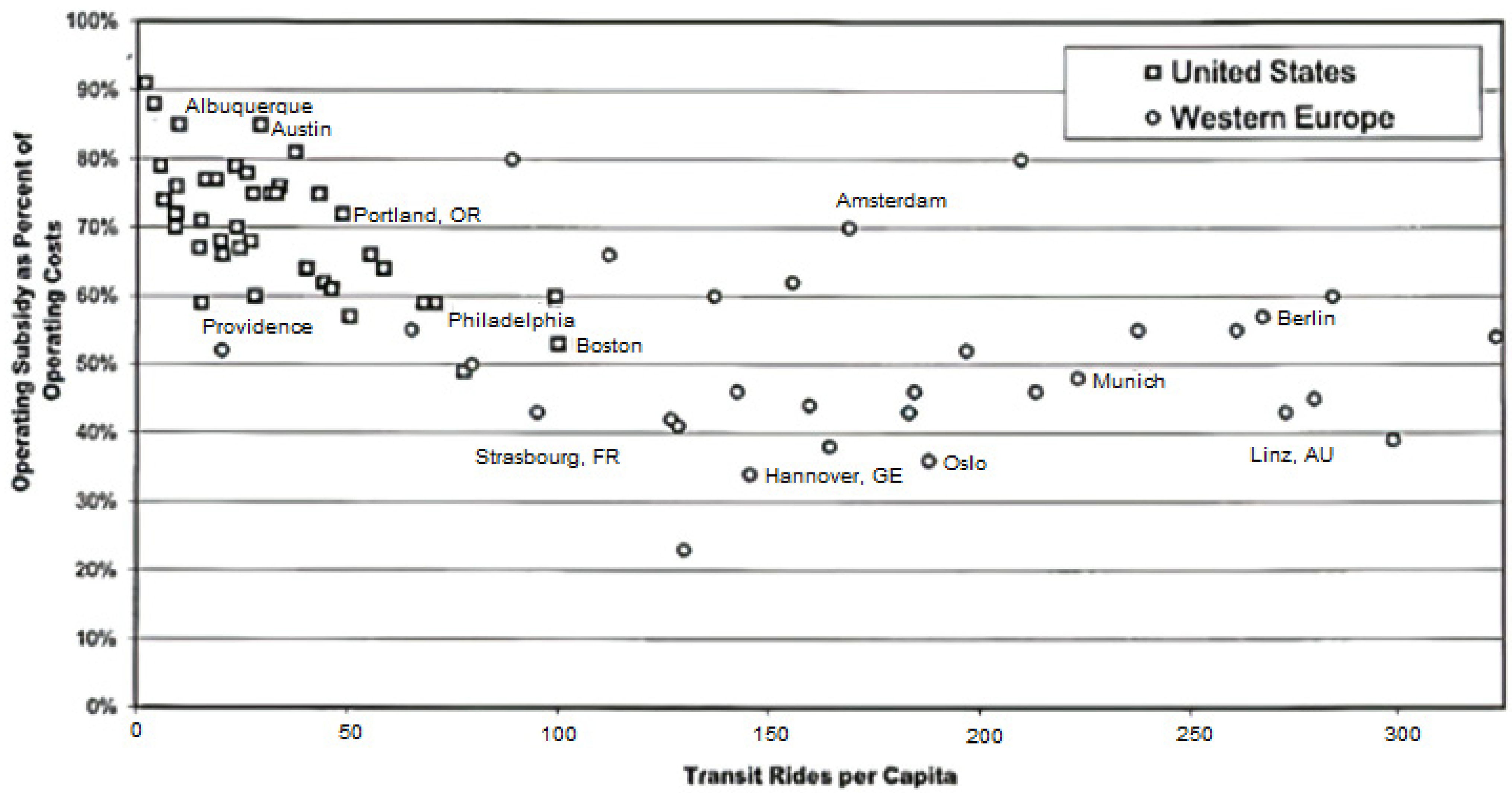

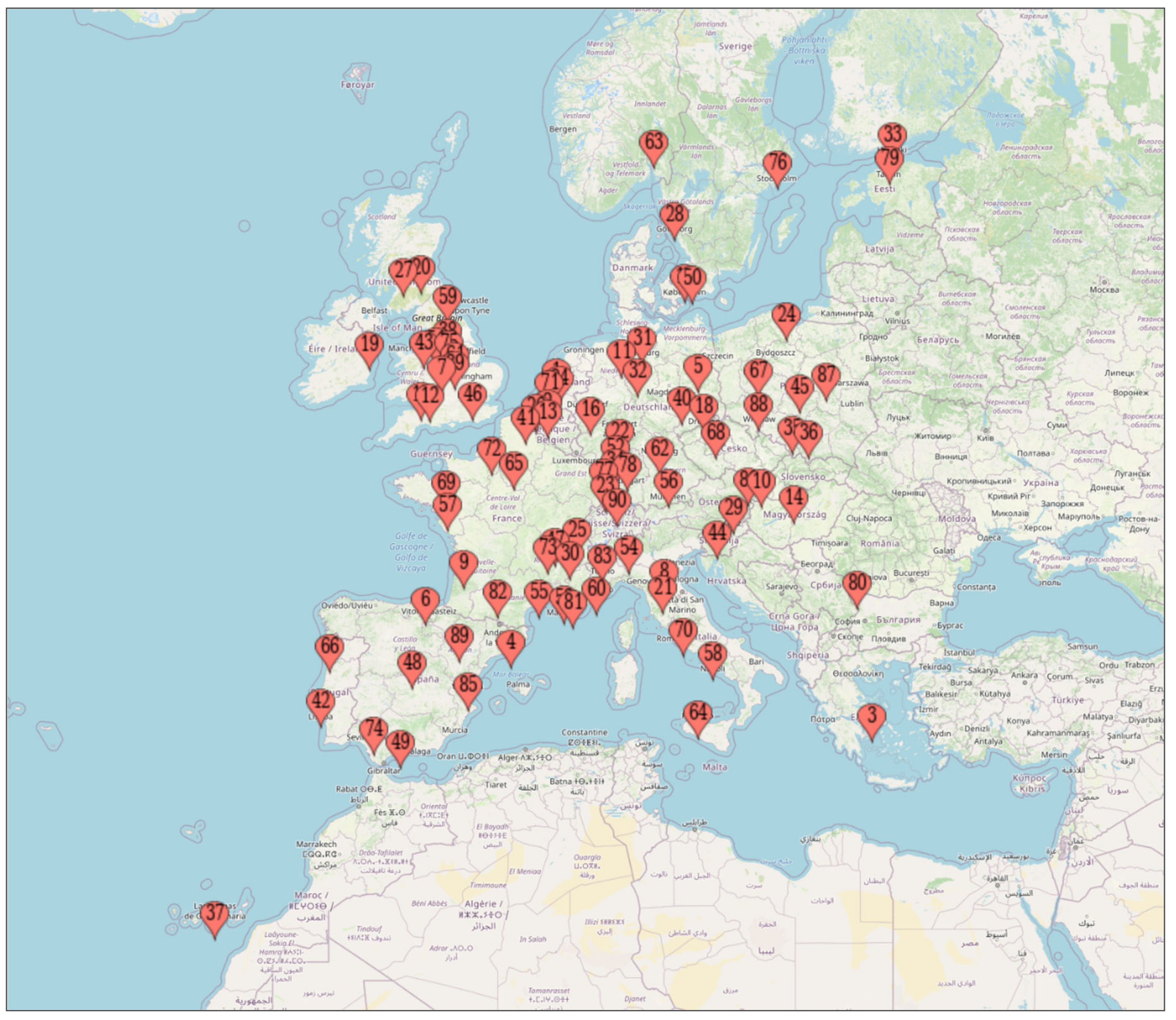


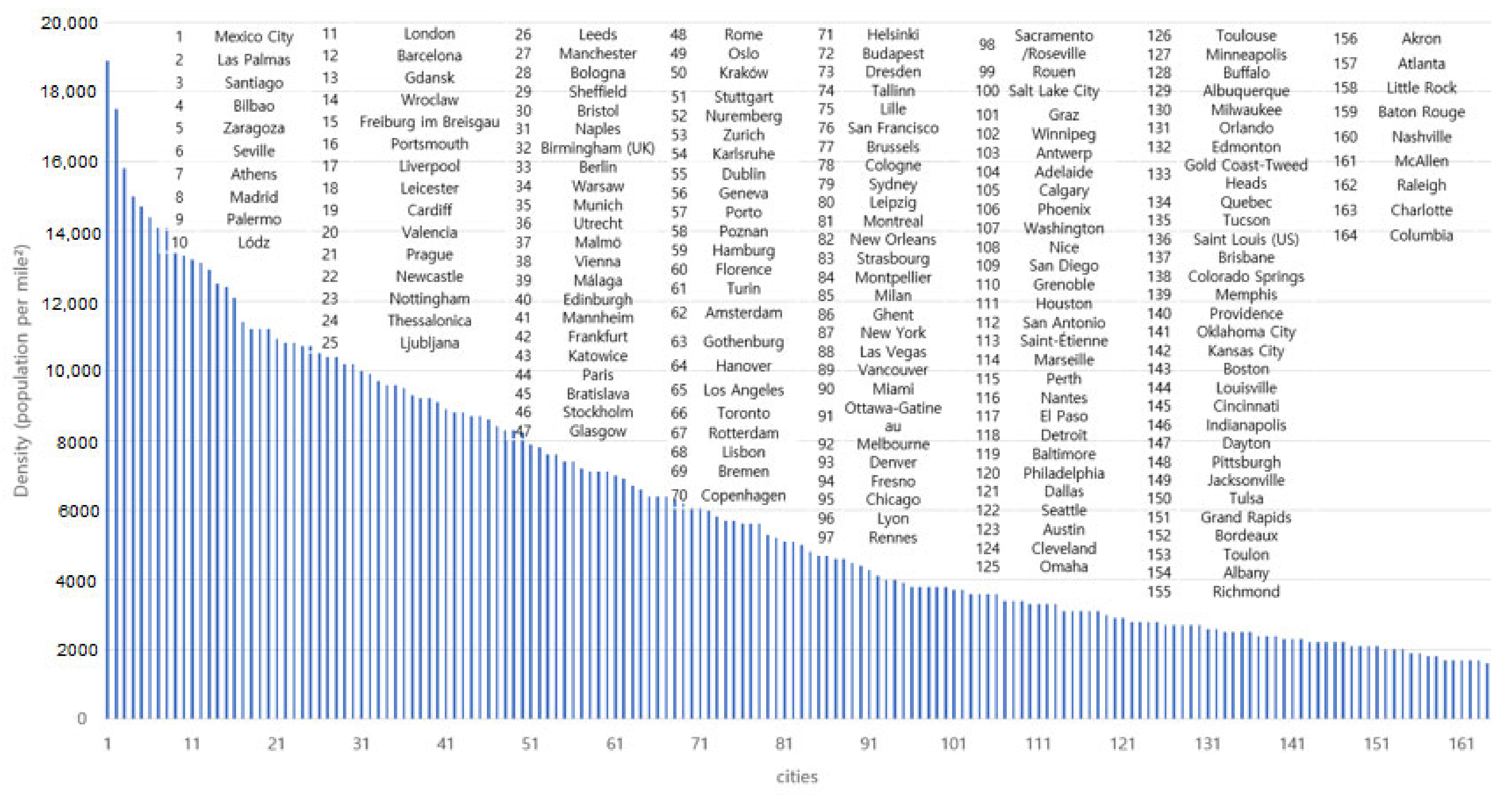

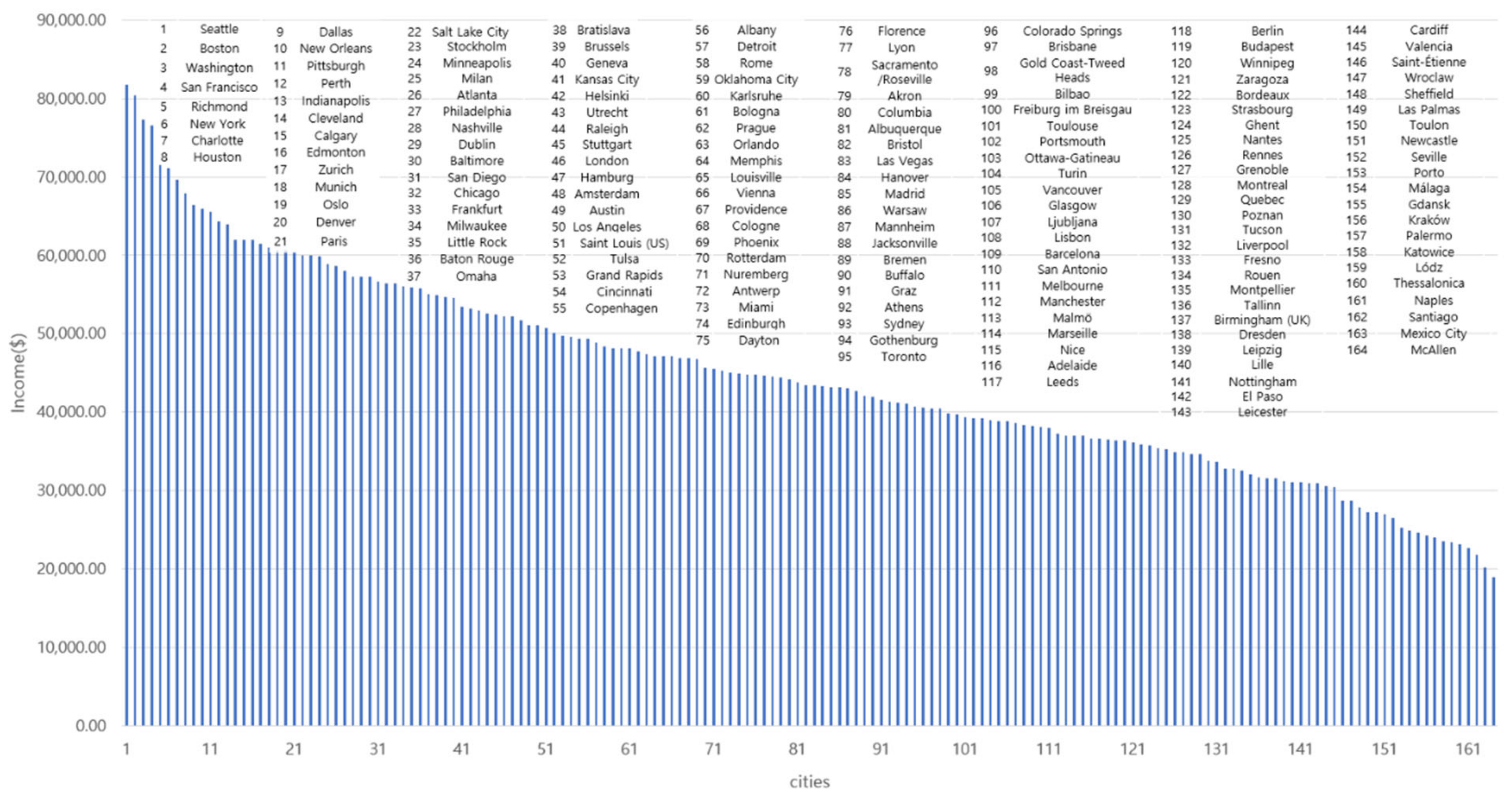

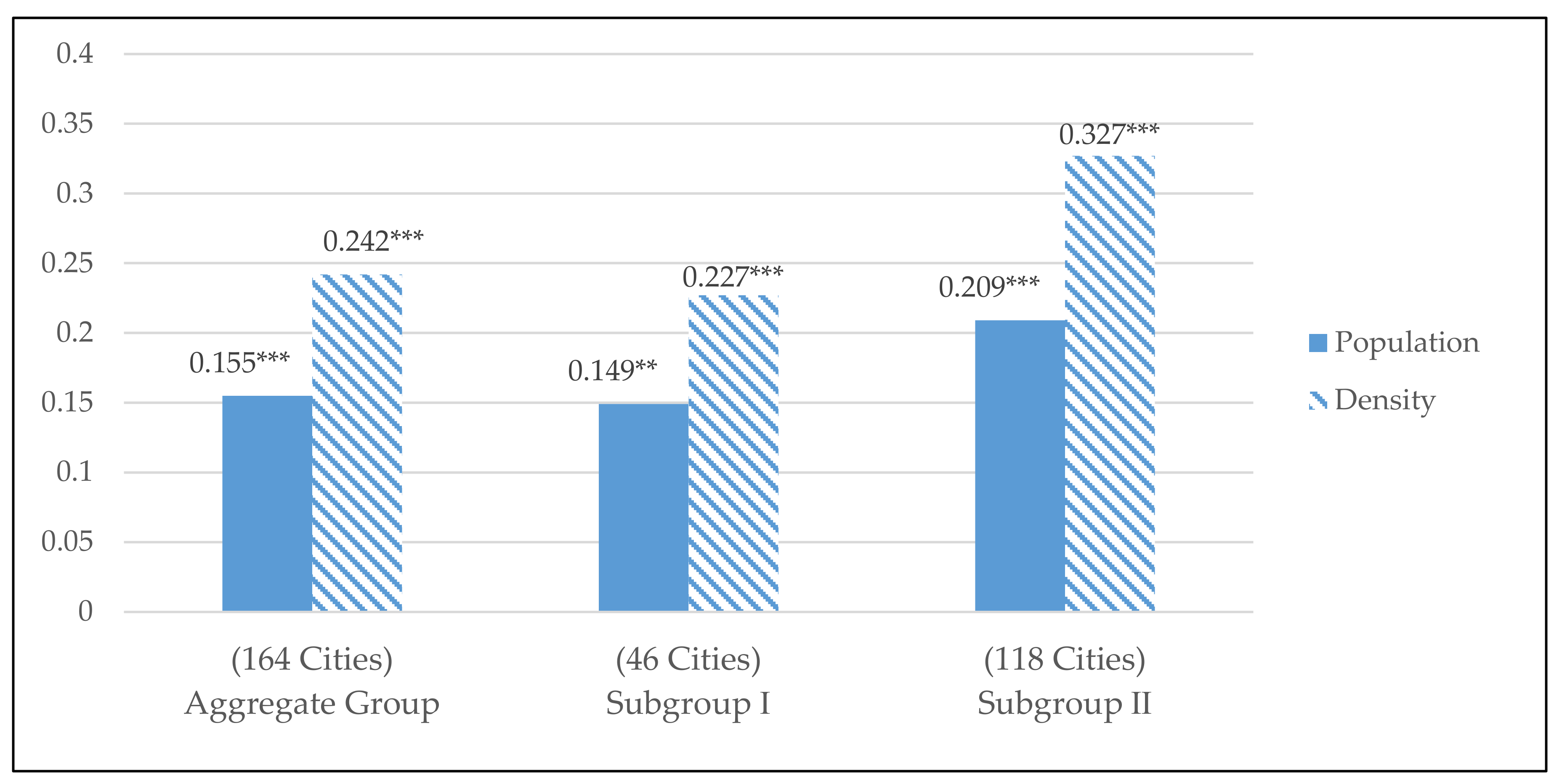
| Cities | Transit Service km per Person | Rail Service Intensity (Service km per Urban ha) | Percentage of Total Motorized Passenger km on Transit | Percentage of Workers Using Transit |
|---|---|---|---|---|
| European (11) | 92 km | 3651 km | 22.6% | 38.8% |
| American (13) | 28 km | 153 km | 3.1% | 9.0% |
| 3.28 times | 23.86 times | 7.29 times | 4.31 times |
| In_Traffic Index | In_Density | In_Population | In_Income | |
|---|---|---|---|---|
| In_Traffic Index | 1.000 | - | - | - |
| In_Density | 0.556 ** | 1.000 | - | - |
| In_Population | 0.351 ** | 0.123 | 1.000 | - |
| In_Income | −0.257 ** | −0.409 ** | 0.27 ** | 1.000 |
| Variable\Group |
Aggregate Group (164 Cities) |
Disaggregate Group 1 (66 Cities) |
Disaggregate Group 2 (98 Cities) |
|---|---|---|---|
| ln_Density | 0.242 *** (0.039) | 0.311 *** (0.077) | −0.004 (0.042) |
| ln_Population | 0.155 *** (0.027) | 0.207 *** (0.039) | 0.155 *** (0.035) |
| ln_Income | −0.200 ** (0.083) | −0.140 (0.142) | −0.137 (0.103) |
| Constant | 1.050 (0.963) | −0.972 (1.553) | 2.632 (1.014) |
| R2 | 0.412 | 0.472 | 0.208 |
| Observation | 164 | 66 | 98 |
| In_Traffic Index | Coef. | Std. Err. | z | P > z | 95% Conf. Interval | ||
|---|---|---|---|---|---|---|---|
| Region 1 (46 Cities) | ln_Density | 0.227 | 0.040 | 5.620 | 0.000 | 0.148 | 0.307 |
| ln_Population | 0.149 | 0.062 | 2.410 | 0.016 | 0.028 | 0.270 | |
| ln_Income | −0.349 | 0.100 | −3.470 | 0.001 | −0.545 | −0.152 | |
| In_cons | 2.845 | 1.312 | 2.170 | 0.030 | 0.273 | 5.417 | |
| Region 2 (118 Cities) | ln_Density | 0.327 | 0.094 | 3.480 | 0.001 | 0.143 | 0.511 |
| ln_Population | 0.209 | 0.080 | 2.630 | 0.009 | 0.053 | 0.365 | |
| ln_Income | 0.165 | 0.159 | 1.040 | 0.300 | −0.147 | 0.477 | |
| In_cons | −4.447 | 2.404 | −1.850 | 0.064 | −9.159 | 0.266 | |
Publisher’s Note: MDPI stays neutral with regard to jurisdictional claims in published maps and institutional affiliations. |
© 2021 by the authors. Licensee MDPI, Basel, Switzerland. This article is an open access article distributed under the terms and conditions of the Creative Commons Attribution (CC BY) license (https://creativecommons.org/licenses/by/4.0/).
Share and Cite
Chang, Y.S.; Jo, S.J.; Lee, Y.-T.; Lee, Y. Population Density or Populations Size. Which Factor Determines Urban Traffic Congestion? Sustainability 2021, 13, 4280. https://doi.org/10.3390/su13084280
Chang YS, Jo SJ, Lee Y-T, Lee Y. Population Density or Populations Size. Which Factor Determines Urban Traffic Congestion? Sustainability. 2021; 13(8):4280. https://doi.org/10.3390/su13084280
Chicago/Turabian StyleChang, Yu Sang, Sung Jun Jo, Yoo-Taek Lee, and Yoonji Lee. 2021. "Population Density or Populations Size. Which Factor Determines Urban Traffic Congestion?" Sustainability 13, no. 8: 4280. https://doi.org/10.3390/su13084280
APA StyleChang, Y. S., Jo, S. J., Lee, Y.-T., & Lee, Y. (2021). Population Density or Populations Size. Which Factor Determines Urban Traffic Congestion? Sustainability, 13(8), 4280. https://doi.org/10.3390/su13084280






